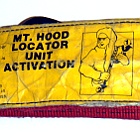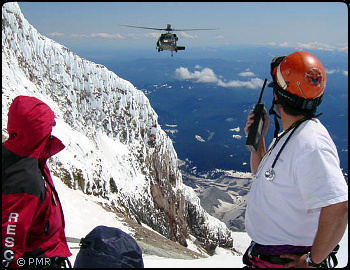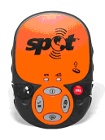 |
 n December 2006, Kelly James, Brian Hall, and Jerry Cooke attempted a
winter ascent of the North Face of Mount Hood. Forty eight hours later,
a storm hit the mountain with winds over 90 mph and several feet of new
snow. The climbers had not returned and it was clear that something was
wrong. James placed a brief cell phone call to his girlfriend, telling
her he was trapped in a snow cave high on the mountain and needed rescue.
Unfortunately, search and rescue (SAR) teams could not reach the upper
mountain due to hurricane-force winds, driving snow, and extreme
avalanche danger. They had to wait several days for safer conditions.
In the meantime, television crews converged on the mountain and broadcast
the drama on the news every night. The nation held its breath for a
week, hoping the climbers would somehow survive the storm. When rescue
teams finally reached the upper mountain, they found the frozen body of
James in the snow cave. Despite intensive searching, Hall and Cooke were
never found. They are presumed dead.
n December 2006, Kelly James, Brian Hall, and Jerry Cooke attempted a
winter ascent of the North Face of Mount Hood. Forty eight hours later,
a storm hit the mountain with winds over 90 mph and several feet of new
snow. The climbers had not returned and it was clear that something was
wrong. James placed a brief cell phone call to his girlfriend, telling
her he was trapped in a snow cave high on the mountain and needed rescue.
Unfortunately, search and rescue (SAR) teams could not reach the upper
mountain due to hurricane-force winds, driving snow, and extreme
avalanche danger. They had to wait several days for safer conditions.
In the meantime, television crews converged on the mountain and broadcast
the drama on the news every night. The nation held its breath for a
week, hoping the climbers would somehow survive the storm. When rescue
teams finally reached the upper mountain, they found the frozen body of
James in the snow cave. Despite intensive searching, Hall and Cooke were
never found. They are presumed dead.
Intense media coverage and public interest in this tragedy spurred
debate about what went wrong and how future accidents might be prevented.
A bill was introduced in the Oregon State Legislature proposing that
Mount Hood climbers be required to carry an electronic signaling device
above 10,000 feet in winter. Portland Mountain Rescue and members of the
climbing community opposed the bill. It was defeated, but the issue
would rise again.
December 2009 brought another severe winter storm and another team of
three climbers missing on Mount Hood. High winds, deep snow, and high
avalanche danger again prevented SAR teams from attempting a rescue.
When the weather broke, the body of one climber was found, but there was
no sign of the other two. They were found dead the next summer. Eight
weeks later a bill was introduced, this time in Washington, requiring
climbers to carry a cell phone or other signaling device when traveling
above tree line in the mountains. SAR groups, National Park officials,
and climbers opposed the bill, and it was withdrawn. It’s likely
that there will be future legislative attempts to require Northwest
climbers to carry signaling devices.
The assumption underlying these bills is that climbers would be safer
if they were required to carry a mobile communication device into the
mountains. To evaluate this assumption, this article will explore
several questions:
- Do mobile communication devices improve outcomes for mountain
search and rescue (SAR)?
- What is the best mobile communication device for Northwest
mountain climbers?
- Will climbers take greater risks if they think they can easily
call in a rescue?
- What equipment is most likely to increase climber safety?
- Would there be unintended consequences of requiring climbers
to carry a signaling device?
Do mobile communication devices improve outcomes for mountain search and rescue?
Park Officials and SAR leaders agree that they can. Examples from
2009-2010 illustrate this (see sidebar). A significant fraction of
climbers use mobile communication devices to call for rescues. In 2005,
23% of SARs in National Parks were initiated by cell or satellite phone,
29% in person, 23% by landline, and 5% by radio. Of 19 SAR missions
reported in Mount Rainier National Park in 2009, four were reported by
mobile phone and five were reported by radio. Three of the nine mountain
rescues in North Cascades National Park in 2009 were reported by cell
phone and one by activation of a SPOT beacon.
In two North Cascades incidents in 2009, parties tried to use a cell
phone in the field but failed to get service. Uninjured members of these
parties had to descend and report the accidents in person at the
Marblemount Ranger Station. These cases illustrate that cell phones
don’t always work when they are needed. Perhaps a different mobile
communication device would have enabled these climbers to get help
faster.
What is the best mobile communication device for mountain climbers?
There is a growing list of devices capable of transmitting a voice or
electronic signal to initiate a mountain rescue operation. No single
device works best in all situations. The most important factor in
choosing a device is whether it will work when needed. Two things must
happen: the device must send a message to its communication network (e.g.
cell tower or satellite), and someone must be available to receive the
message and initiate a rescue. Below is a summary of some of the pros
and cons of these technologies:
Personal Locator Beacons (PLBs)
A high-power beacon used to initiate a rescue and provide a homing
signal to assist searchers.
- Pros: High transmission power (5 Watts) and low operating
frequency (406 and 121 MHz) enable a PLB to effectively transmit a
distress signal and act as a homing beacon. Dispatchers are
available 24/7 to respond to signals and contact regional
authorities to request initiation of an SAR operation. This
technology has been used for emergency signaling in aviation and
boating for many years.
- Cons: No two-way communication. The PLB cannot cancel a
rescue that has been initiated.
- Cost: $250 for the McMurdo FastFind. No contract cost.
SPOT beacons
A lower-power beacon with a variety of non-emergency functions.
- Pros: Private satellites and dispatchers are available 24/7 to
initiate rescues. Multiple pre-set messages can be sent, including
one to cancel a rescue request. Optional GPS tracking and other
features are available.
- Cons: No two-way communication. Its less powerful signal (0.4
Watts) and higher operating frequency (1600 MHz) make it less likely
than a PLB to be able to transmit a signal through trees or snow.
- Cost: $170 for the SPOT II. $99 or more for the annual
contract, depending on options selected.
 |  |
|
MLU sewn into a shoulder strap. |
|
 |
Mountain Locator Unit (MLU)
A device used to help locate victims once a rescue has been initiated by
other means.
- Pros: Low operating frequency (168 MHz) allows reliable
transmission from snow caves and in the woods. Units are charged and
maintained by County Sheriff’s offices and will signal
continuously for many days once activated. Rescuers can use an MLU
signal to pinpoint missing climbers using the same methods used to
track radio-collared animals.
- Cons: MLU signals are not monitored unless a rescue has been
activated by a report of an overdue climber or a 9-1-1 call. MLUs
only work on Mount Hood. There is no communication between victims
and rescuers, between victims and other parties, or between MLU
units.
- Cost: $5/day rental. Not available for purchase.
Cell phones
Versatile and ubiquitous devices that don’t always work when
needed.
- Pros: Most people already have one so price is largely
irrelevant. Transmission at 850 and 1900 MHz allows increased
fidelity compared to single band units. Two-way communication with
rescuers and others is possible. A host of other useful features
may be available, including texting, internet access, a digital
camera, GPS, compass, weather reports, and more.
- Cons: Cell coverage is spotty in many popular climbing areas
and unavailable in more remote locations. Transmission power may
be too low to reach distant cell towers.
- Cost: Unit costs and monthly fees vary widely.
 |  |
|
Iridium 9555 satellite phone. |
|
 |
Satellite phones
Expensive but reliable phones with few accessory features.
- Pros: Can make calls almost anywhere in the world, including
Northwest mountains. Two-way communication with rescuers and
others is possible.
- Cons: Expensive. Callers may need to wait a few minutes or
more for a satellite to pass overhead.
- Cost: $1349 for the Iridium 9555 or $45/week rental plus usage
charges.
SAR leaders and park officials agree that two-way communication is
valuable because they can confirm a distress call and sometimes provide
victims with assistance remotely. Such assistance could include
first-aid advice or route-finding directions. Two-way communication also
makes it possible for a party to communicate that they are delayed but
don’t require rescue. One-way signaling devices can’t
provide these benefits and are more prone to false alarms. With no way
to verify the validity of a call for help, SAR teams must respond to
every call and device activation as if someone’s life depended on
it. Most rescuers encourage climbers to carry and use mobile
communication devices, but some have concerns that these devices may
induce climbers to take more risks than they would without one.
|

|
| Recent Cell Phone SAR Calls |
|
• Summer 2009, North Cascades
A climber fell 60 feet on the North Buttress of Mount Terror,
breaking his femur and sustaining serious head injuries. His
partners climbed to the summit, hoping for cell phone coverage. They
were able to call 9-1-1 and reach North Cascades Ranger Kelly Bush.
She dispatched a helicopter rescue team that plucked the injured
climber off the mountain and transferred him to Harborview Medical
Center. The climber has made a full recovery. (See story in this NWMJ issue.)
• Summer 2009, Mount Hood
A late-night cell phone call was received from a climbing party
descending the south side of Mount Hood. They were overdue and
disoriented. Monty Smith of Portland Mountain Rescue was able to
determine their location and talk them safely back to Timberline
Lodge. No one was hurt, no rescue was initiated, and Smith and
his colleagues never had to step outside.
• Winter 2010, Crystal Mtn Ski Area
A solo skier was swept down a gully by an avalanche, slammed into
a tree, and pinned by avalanche debris. He broke his hip,
sustained internal injuries, and was rapidly becoming
hypothermic. Fortunately, he was able to make a cell phone call
to the Crystal Ski Patrol, who initiated a successful ground
rescue. The skier spent five days in Harborview Medical Center
and is on the road to recovery.
• Spring 2010, Snoqualmie Pass
A lone hiker was swept off the Granite Mountain trail and buried
by an avalanche. He was trapped under the snow but extremely
lucky, explaining “My legs were completely cramped, but I
had a little space. It was about a foot wide (with) a hole going
up to the surface, so I had a little light and air coming
through.” He used his cell phone to call 9-1-1 from beneath
the snow and initiate a rescue. Rescuers found him and dug him
out. Other than bruising and hypothermia, he was unhurt. Like
the solo skier above, this individual probably would have died if
he hadn’t been able to use his phone to initiate a rapid
rescue.
• Spring 2010, Mount Rainier
Two climbers fell 75 feet into a large crevasse just below Camp
Muir. They called 9-1-1 from the bottom of the crevasse, but bad
weather delayed rescue teams. Fortunately, the party had camping
gear with them. They pitched a tent on a ledge inside the
crevasse and waited in their sleeping bags until rescuers arrived
to pull them up to safety.
|
 |
| Cell Phone Failures
|
 |
|
Two rescues in the North Cascades in 2009 involved parties who
tried to use a cell phone in the field but failed to get service.
Uninjured members of each party had to descend to report the
accidents in person at the Marblemount Ranger Station. These cases
illustrate that cell phones don’t always work when and where
they are needed.
|
| |
|
 |







